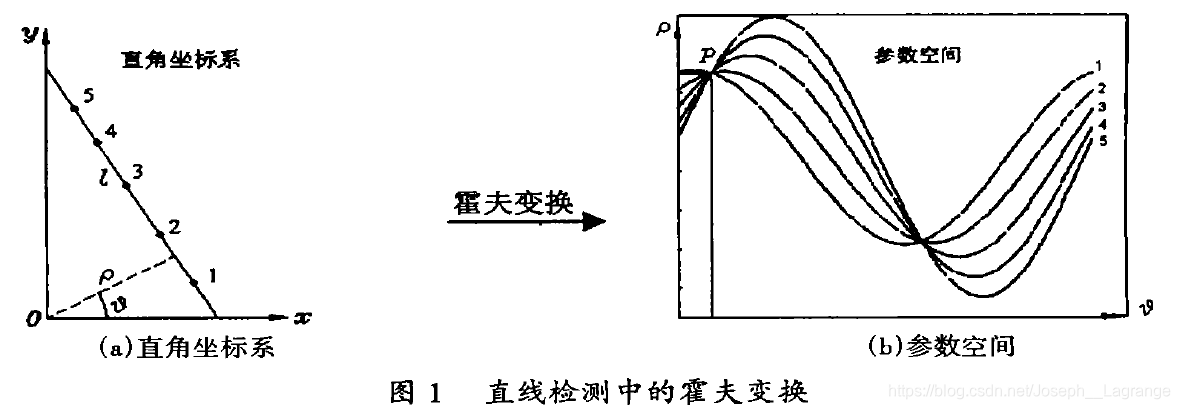掌握霍夫变换直线检测:图像处理的必备技能
发布时间: 2024-08-10 15:59:30 阅读量: 21 订阅数: 33 


霍夫变换算法_直线检测_matlab

# 1. 霍夫变换简介
霍夫变换是一种用于图像处理中的强大技术,用于检测图像中的特定形状,例如直线、圆形和椭圆形。它是一种基于投票的算法,通过将图像中的每个点映射到参数空间中的曲线或曲面来工作。
在霍夫变换中,对于要检测的每个形状,都会创建一个参数空间。对于直线检测,参数空间由斜率和截距组成。然后,图像中的每个点都投票给参数空间中表示该点所在直线的曲线。最终,具有最高投票数的曲线对应于图像中检测到的直线。
# 2. 霍夫变换直线检测理论
### 2.1 霍夫变换的基本原理
#### 2.1.1 霍夫空间的建立
霍夫变换的基本思想是将图像中的点映射到参数空间(称为霍夫空间)中。对于直线检测,霍夫空间是一个二维空间,其中横轴表示直线的斜率,纵轴表示直线的截距。
**建立霍夫空间的步骤:**
1. 遍历图像中的每个像素点。
2. 对于每个像素点,计算所有可能通过该点的直线的参数。
3. 在霍夫空间中,对每个参数对(斜率、截距)进行累加。
#### 2.1.2 霍夫空间的投票
在霍夫空间中,每个点代表一条直线。当多个点映射到同一个点时,表示这些点位于同一条直线上。因此,霍夫空间中的每个点的值表示通过该点的直线的数量。
### 2.2 霍夫变换直线检测的算法步骤
#### 2.2.1 图像边缘检测
霍夫变换直线检测的第一步是检测图像中的边缘。边缘是图像中亮度或颜色发生突然变化的地方,通常表示对象的边界或轮廓。
#### 2.2.2 霍夫空间的建立
根据边缘点,建立霍夫空间。对于每个边缘点,计算所有可能通过该点的直线的参数,并在霍夫空间中对这些参数进行累加。
#### 2.2.3 霍夫空间的投票
对霍夫空间进行投票,累加每个点的值。投票次数高的点表示通过这些点的直线数量较多,即为图像中的直线。
#### 2.2.4 直线参数的提取
从霍夫空间中提取直线参数。投票次数高的点对应于图像中的直线。通过这些点的斜率和截距,可以获得直线方程。
**代码示例:**
```python
import cv2
import numpy as np
def hough_lines(image):
# 图像边缘检测
edges = cv2.Canny(image, 100, 200)
# 霍夫空间建立
hough_space = np.zeros((max_rho, max_theta), dtype=np.uint8)
# 霍夫空间投票
for y in range(image.shape[0]):
for x in range(image.shape[1]):
if edges[y, x] > 0:
for theta in range(max_theta):
rho = int(x * np.cos(theta) + y * np.sin(theta))
hough_space[rho, theta] += 1
# 直线参数提取
lines = []
for rho in range(max_rho):
for theta in range(max_theta):
if hough_space[rho, theta] > threshold:
lines.append((rho, theta))
return lines
```
**代码逻辑分析:**
* `hough_lines()` 函数接收一个图像作为输入,返回检测到的直线列表。
* `Canny()` 函数用于检测图像边缘。
* `hough_space` 数组表示霍夫空间,其中 `max_rho` 和 `max_theta` 分别是霍夫空间的行列数。
* 遍历图像中的每个像素点,对于每个边缘点,计算所有可能通过该点的直线的参数,并在霍夫空间中进行累加。
* 遍历霍夫空间,提取投票次数高的点,并根据这些点的斜率和截距计算直线方程。
# 3. 霍夫变换直线检测实践
### 3.1 OpenCV中的霍夫变换函数
OpenCV提供了两个用于霍夫变换直线检测的函数:
- **HoughLines()函数:**该函数使用标准霍夫变换算法检测图像中的直线。它返回一个包含检测到的直线参数的数组。
- **HoughLinesP()函数:**该函数使用概率霍夫变换算法检测图像中的直线。它返回一个包含检测到的直线端点的数组。
#### 3.1.1 HoughLines()函数
**参数:**
- **image:**输入图像,必须是灰度或二值图像。
- **rho:**霍夫空间中直线与原点的距离分辨率。
- **theta:**霍夫空间中直线角度分辨率。
- **threshold:**累积器中每个单元格的阈值,用于确定直线。
- **minLineLength:**检测到的直线的最小长度。
- **maxLineGap:**检测到的直线之间的最大间隙。
**返回值:**
- **lines:**一个包含检测到的直线参数的数组。每个直线由其距离原点的距离(rho)和角度(theta)表示。
**代码块:**
```python
import cv2
import numpy as np
# 读取图像
image = cv2.imread('image.jpg', cv2.IMREAD_GRAYSCALE)
# 应用霍夫变换检测直线
lines = cv2.HoughLines(image, 1, np.pi / 180, 100, minLineLength=100, maxLineGap=10)
# 绘制检测到的直线
for line in lines:
rho, theta = line[0]
a = np.cos(theta)
b = np.sin(theta)
x0 = a * rho
y0 = b * rho
x1 = int(x0 + 1000 * (-b))
y1 = int(y0 + 1000 * (a))
x2 = int(x0 - 1000 * (-b))
y2 = int(y0 - 1000 * (a))
cv2.line(image, (x1, y1), (x2, y2), (0, 0, 255), 2)
# 显示图像
cv2.imshow('Detected Lines', image)
cv2.waitKey(0)
cv2.destroyAllWindows()
```
**逻辑分析:**
该代码块使用HoughLines()函数检测图像中的直线。它首先读取图像并将其转换为灰度图像。然后,它使用指定的分辨率和阈值应用霍夫变换。检测到的直线存储在lines数组中,然后绘制在图像上。
#### 3.1.2 HoughLinesP()函数
**参数:**
- **image:**输入图像,必须是灰度或二值图像。
- **rho:**霍夫空间中直线与原点的距离分辨率。
- **theta:**霍夫空间中直线角度分辨率。
- **threshold:**累积器中每个单元格的阈值,用于确定直线。
- **minLineLength:**检测到的直线的最小长度。
- **maxLineGap:**检测到的直线之间的最大间隙。
**返回值:**
- **lines:**一个包含检测到的直线端点的数组。每个直线由其端点的坐标(x1, y1)和(x2, y2)表示。
**代码块:**
```python
import cv2
import numpy as np
# 读取图像
image = cv2.imread('image.jpg', cv2.IMREAD_GRAYSCALE)
# 应用霍夫变换检测直线
lines = cv2.HoughLinesP(image, 1, np.pi / 180, 100, minLineLength=100, maxLineGap=10)
# 绘制检测到的直线
for line in lines:
x1, y1, x2, y2 = line[0]
cv2.line(image, (x1, y1), (x2, y2), (0, 0, 255), 2)
# 显示图像
cv2.imshow('Detected Lines', image)
cv2.waitKey(0)
cv2.destroyAllWindows()
```
**逻辑分析:**
该代码块使用HoughLinesP()函数检测图像中的直线。它首先读取图像并将其转换为灰度图像。然后,它使用指定的分辨率和阈值应用霍夫变换。检测到的直线存储在lines数组中,然后绘制在图像上。
### 3.2 霍夫变换直线检测的应用实例
霍夫变换直线检测在图像处理中有着广泛的应用,包括:
#### 3.2.1 直线检测和提取
霍夫变换直线检测可以用于检测和提取图像中的直线。这在许多应用中很有用,例如:
- **医学图像分析:**检测骨骼和血管。
- **工业检测:**检测产品缺陷和识别物体。
- **道路检测:**检测道路和车道线。
#### 3.2.2 图像分割和识别
霍夫变换直线检测可以用于分割图像和识别对象。例如:
- **文本识别:**检测文本行和单词。
- **物体识别:**检测物体的边缘和轮廓。
- **建筑物检测:**检测建筑物的墙壁和屋顶。
# 4. 霍夫变换直线检测的优化
### 4.1 霍夫变换直线检测的优化算法
#### 4.1.1 累积器优化
**问题:** 霍夫变换的累积器空间通常很大,这会导致内存消耗和计算复杂度高。
**优化方法:**
* **稀疏累积器:**仅存储累积器中非零的元素,从而减少内存消耗。
* **分块累积器:**将累积器划分为较小的块,仅对包含边缘点的块进行累积,从而减少计算复杂度。
#### 4.1.2 投票优化
**问题:** 霍夫变换的投票过程可能产生大量的冗余投票,导致检测结果不准确。
**优化方法:**
* **加权投票:**根据边缘点的强度或可靠性为投票赋予不同的权重,从而抑制冗余投票。
* **概率霍夫变换:**使用概率模型对边缘点进行采样,减少冗余投票的产生。
### 4.2 霍夫变换直线检测的并行化
#### 4.2.1 多线程并行化
**原理:** 将霍夫变换的计算任务分配给多个线程,同时处理不同的边缘点或累积器空间的一部分。
**代码示例:**
```python
import threading
def parallel_hough_transform(edges):
# 创建线程池
threads = []
# 每个线程处理一部分边缘点
for i in range(num_threads):
start = i * len(edges) // num_threads
end = (i + 1) * len(edges) // num_threads
thread = threading.Thread(target=hough_transform, args=(edges[start:end],))
threads.append(thread)
# 启动线程
for thread in threads:
thread.start()
# 等待线程完成
for thread in threads:
thread.join()
```
#### 4.2.2 GPU并行化
**原理:** 利用 GPU 的并行计算能力,同时处理大量的边缘点或累积器空间。
**代码示例:**
```python
import cupy as cp
def gpu_hough_transform(edges):
# 将边缘点转换为 GPU 数组
edges_gpu = cp.asarray(edges)
# 在 GPU 上执行霍夫变换
hough_transform_gpu = cp.cuda.reduce(edges_gpu, axis=0, keepdims=True)
# 将结果从 GPU 复制回 CPU
hough_transform = hough_transform_gpu.get()
```
# 5.1 医学图像分析
### 5.1.1 骨骼检测
霍夫变换在医学图像分析中广泛用于骨骼检测。骨骼具有明显的线状特征,因此非常适合霍夫变换的应用。通过对医学图像进行霍夫变换,可以提取出骨骼的边缘和轮廓,从而辅助诊断和治疗。
```python
import cv2
import numpy as np
# 读取医学图像
image = cv2.imread('bone_image.jpg', cv2.IMREAD_GRAYSCALE)
# 边缘检测
edges = cv2.Canny(image, 100, 200)
# 霍夫变换
lines = cv2.HoughLinesP(edges, 1, np.pi / 180, 100, minLineLength=100, maxLineGap=10)
# 绘制骨骼轮廓
for line in lines:
x1, y1, x2, y2 = line[0]
cv2.line(image, (x1, y1), (x2, y2), (0, 255, 0), 2)
# 显示结果
cv2.imshow('Bone Detection', image)
cv2.waitKey(0)
cv2.destroyAllWindows()
```
### 5.1.2 血管检测
霍夫变换还可以用于血管检测。血管在医学图像中表现为细长的线状结构,可以通过霍夫变换提取其特征。血管检测对于疾病诊断和治疗至关重要,如心血管疾病和肿瘤检测。
```python
import cv2
import numpy as np
# 读取医学图像
image = cv2.imread('vessel_image.jpg', cv2.IMREAD_GRAYSCALE)
# 边缘检测
edges = cv2.Canny(image, 100, 200)
# 霍夫变换
lines = cv2.HoughLinesP(edges, 1, np.pi / 180, 100, minLineLength=50, maxLineGap=10)
# 绘制血管轮廓
for line in lines:
x1, y1, x2, y2 = line[0]
cv2.line(image, (x1, y1), (x2, y2), (0, 0, 255), 2)
# 显示结果
cv2.imshow('Vessel Detection', image)
cv2.waitKey(0)
cv2.destroyAllWindows()
```
0
0





